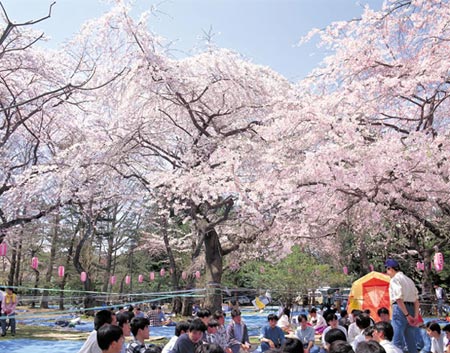Japanese cherry blossoms are threatened
For Japanese people, the cherry blossom season signals the winter is over and spring is coming. But this flower is blooming sooner and will face a gloomy future due to global warming.

Japanese people often hold a party to watch flowers under cherry trees.Photo: kyoto.travel.
This year, the cherry blossom season officially begins on March 21, which means 5 days earlier than expected and a week earlier than the average flowering period during the past 30 years.
The Japan Meteorological Agency confirmed that he dug early, not an abnormal phenomenon that only occurred once. In fact, this situation has occurred continuously for many years. Normally, cherry blossoms on Japan's southern islands will hatch as early as the second half of March each year, then turn cherry trees on the central island of Honshu and the northern islands.
40 years ago, the cherry on Honshu island began to hatch into 1/4. However, the Japan Hydrometeorological Agency said that in the last few years, digging on islands some 200 km north of Honshu has begun to hatch into 1/4. The cause of this change is global warming and urbanization.
Sumiko, 76, and living in Tokyo's Naka-meguro district, said: 'I came to the capital more than 40 years ago. Then cherry blossoms bloom around April 10. But in recent years they often bloom in the period of March 20-25.
Experts say the temperature in the city is always much higher than in the countryside due to the presence of millions of cars, air conditioners, and heating systems. Cities lack open space but there are too many substances that absorb heat from the Sun (such as concrete, asphalt).
Nobuyuki Asada, a member of the Japanese Cherry Blossom Lovers Association, judged that climate changes made the future of cherry blossoms gloomy. 'If the air temperature continues to increase and the rainy season becomes more and more erratic, I'm not sure if cherry trees can last for 50 or 100 years. Many trees have stopped flowering, 'Asada said.
Every year, the Japan Meteorological Administration always tries to accurately predict the date when cherry blossoms bloom in each region of the country. This is a very important job of the people of Phu Tang who have a habit of holding a view of cherry blossoms for weeks before the flowers bloom. At those parties, people invite friends, relatives and colleagues to cherry trees to eat and watch flowers.
Although presiding over the Kyoto conference on greenhouse gas emissions reduction in 1997, Japan has not yet been considered an exemplary country in its efforts to prevent climate change. Under the Kyoto Protocol, the land of the rising sun must cut 6% of greenhouse gas emissions by 1990. But the latest statistics show that Asia's largest economy still produces 'annually'. Greenhouse gas emissions are 9.2% higher than 1990 levels.
- Cherry blossom season flourishes in Japan through ecstatic beautiful pictures
- Cherry blossoms make you want to go to Japan immediately
- Admire the cherry tree which is classified by the Japanese government as a national treasure
- Japan: What makes the cherry blossoms blooming early in large scale?
- Beams of images: Cherry blossoms are beautiful to welcome Tet 2016
- Japanese people fever with cherry trees
- Not Japan, this is the cherry capital of the world
- Why is Japan called the Land of Funan?
- Peach spring blooming in the east wind
- Cherry blossoms, blooming plum blossoms on Ha Giang stone plateau
- What kind of special thing does it have to do with the price of tens, hundreds of millions of VND?
- How to make peach blossom bloom right Tet
 Is the magnetic North Pole shift dangerous to humanity?
Is the magnetic North Pole shift dangerous to humanity? Washington legalizes the recycling of human bodies into fertilizer
Washington legalizes the recycling of human bodies into fertilizer Lightning stone - the mysterious guest
Lightning stone - the mysterious guest Stunned by the mysterious sunset, strange appearance
Stunned by the mysterious sunset, strange appearance Notes when eating cherries to not affect health
Notes when eating cherries to not affect health  Interesting question: 'Do cherry blossom trees bear fruit?'
Interesting question: 'Do cherry blossom trees bear fruit?'  A unique tree that looks like it was cast in bronze, typical of Tibet
A unique tree that looks like it was cast in bronze, typical of Tibet  Japanese cherry blossoms may disappear
Japanese cherry blossoms may disappear  Sour cherry 'super food' helps increase memory, lower blood pressure and cholesterol
Sour cherry 'super food' helps increase memory, lower blood pressure and cholesterol  Cherry blossom galaxies flourish, glowing mysterious pink light
Cherry blossom galaxies flourish, glowing mysterious pink light 